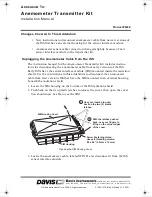
SECTION 3. TROUBLESHOOTING
3-4
Rain Gage
The Rain Gage has a reed switch that closes as
the tipping bucket tips. To check the Rain
Gage, connect the Ohm meter to the two wires
and tip the bucket VERY SLOWLY past the
center point. As this is done, you should get
some continuity through the circuit. If there is
NO continuity, then the reed switch is probably
bad.
Temperature and Relative Humidity,
Systems shipped prior to January 1, 1991
TEMPERATURE AND RELATIVE HUMIDITY,
SYSTEMS SHIPPED AFTER JANUARY 1,
1991
NOTE: DO NOT
connect an Ohm meter to
the temperature and relative humidity
probe.
Things to look for if you are experiencing
problems with the temperature and relative
humidity probe:
1.
Are both the temperature AND the relative
humidity readings bad? If so, make sure
the radiation shield and sensor endcap are
free from debris. The sensor should also
be removed and the screen taken off to
inspect the screen, RH chip, and thermistor.
2.
Is just the temperature reading bad? Again,
make sure the radiation shield and sensor
endcap are free from debris.
3.
Is just the relative humidity reading bad? In
this case, the probe needs to be
recalibrated. (Contact Campbell Scientific if
facilities to recalibrate are unavailable.)
In any of the above cases the sensor leads
should be checked for breaks or corrosion
on the connections to the datalogger.
If you are suspecting improper readings, and if
facilities exist, the temperature and relative
humidity probe should be placed in a sealed
container over deionized water for two hours.
After two hours it should read close to 100%
RH. If the readings are greater than 5% off
from 100% the probe needs to be recalibrated
or repaired.
NOTE: DO NOT connect an OHM meter
across the RH (relative humidity) chip, or it
will be damaged.
Things to look for if you are experiencing
problems with the temperature and relative
humidity probe:
1.
Are both temperature relative humidity
readings bad?
2.
Is just the temperature reading bad?
3.
Is just the relative humidity reading bad?
The RH measurement has a temperature
compensation built in to it. Therefore, if the
temperature reading is bad, then the RH
reading is probably bad.
To measure the resistance of the temperature
portion of the sensor, the RH chip (PCRC-11)
must be removed (Figure 3.2-1). Remove the
sensor from the radiation shield. The sensor is
held inside the radiation shield by two plastic
retainers on the bottom of the shield. Loosen
the screws holding the retainers and rotate the
two retainers to one side so the sensor can be
removed. Loosen the two screws from the
protective screen. Take the screen off to
expose the RH chip. HANDLE THE CHIP
CAREFULLY
and by the two edges ONLY.
Remove the chip by carefully grasping the sides
of the chip and pulling it out of the sockets. DO
NOT TOUCH THE RELATIVE HUMIDITY
CHIP! Dirt and oil will give poor readings.
ALSO, BE CAREFUL OF THE DELICATE
THERMISTOR LEADS.
Summary of Contents for NW8002
Page 12: ...1 7 FIGURE 1 4 1 NW8002 Cement Base FIGURE 1 4 2 NW8002 Tower with Tilt Base...
Page 34: ...A 1 APPENDIX A SENSOR SCHEMATICS...
Page 35: ...APPENDIX A SENSOR SCHEMATICS A 2...
Page 36: ...APPENDIX A SENSOR SCHEMATICS A 3...
Page 37: ...APPENDIX A SENSOR SCHEMATICS A 4...









































